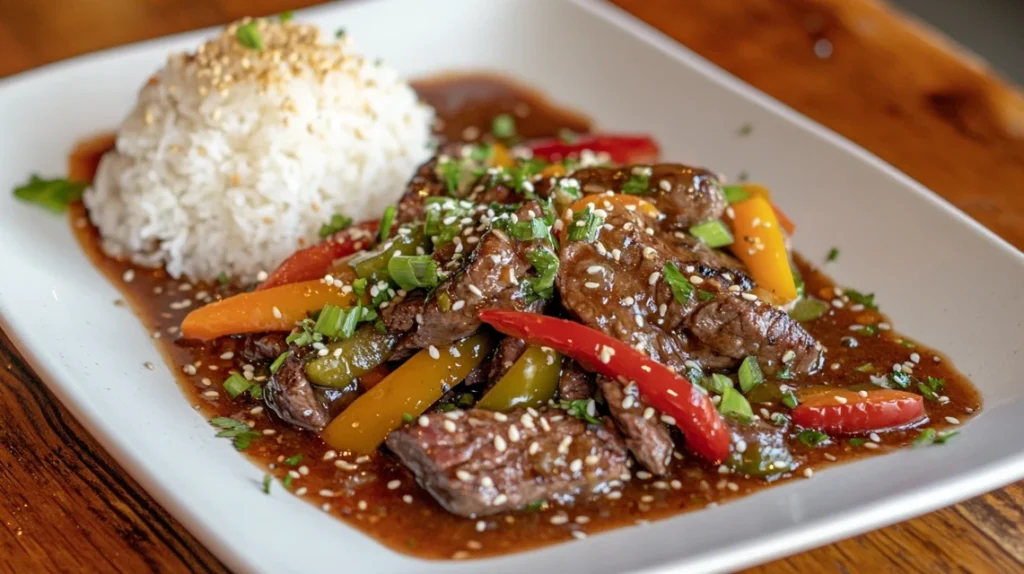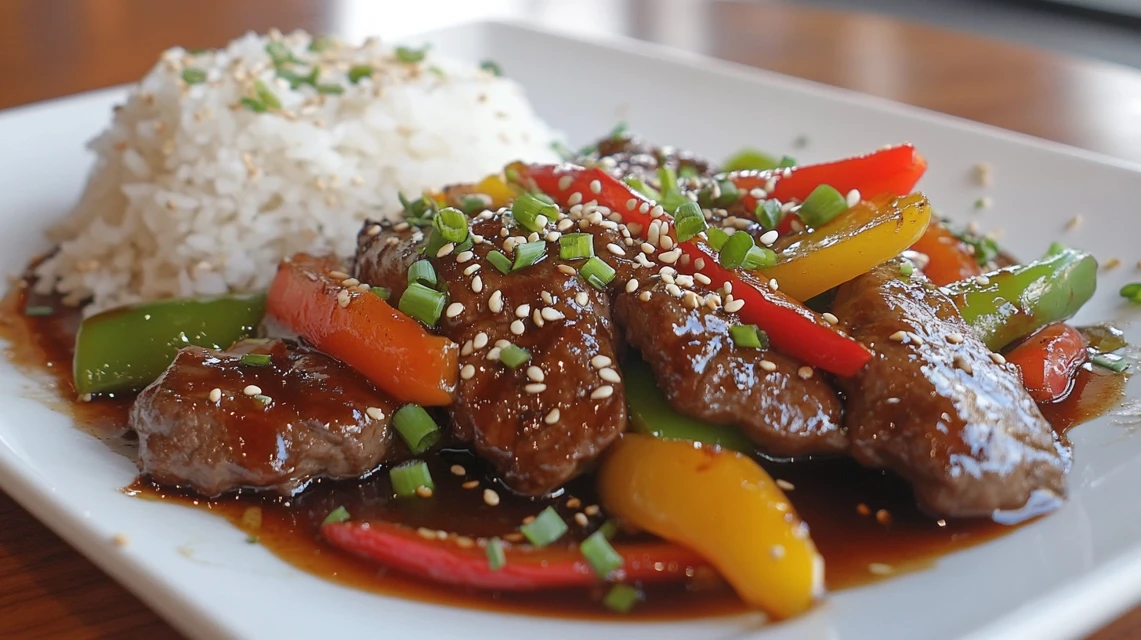Pepper Steak Recipe: A Flavorful and Easy Guide
There’s nothing like a pepper steak recipe that hits all the right notes—juicy beef, crunchy bell peppers, and a savory sauce that ties it all together. Whether you’re a beginner in the kitchen or a seasoned chef, mastering this dish is easier than you think. In just a few steps, you’ll create a restaurant-quality pepper steak that’s perfect for weeknight dinners or special occasions. Ready to dive in? Let’s get cooking!
Introduction to Pepper Steak Recipe
What Is Pepper Steak Recipe?
Pepper steak is a stir-fried dish that combines tender strips of beef with vibrant bell peppers in a flavorful sauce. It’s the perfect mix of texture and taste—soft, savory beef with crunchy veggies. It’s often served over steamed rice or noodles, making it a hearty and satisfying meal.
But don’t let its restaurant-quality vibe fool you; this dish is super simple to make at home. All you need is the right ingredients, a few cooking tips, and a little enthusiasm. Trust me, once you nail this recipe, you’ll want to make it every week.
A Brief History of Pepper Steak Recipe
Did you know that pepper steak has roots in both Chinese and American cuisine? While stir-frying beef with vegetables is a traditional Chinese technique, the inclusion of bell peppers and the sweeter sauce make this dish a Western adaptation. It’s like the best of both worlds collided on your plate.
Why Pepper Steak Is a Crowd Favorite
What’s not to love about pepper steak? It’s a one-pan dish, which means less cleanup. It’s versatile—you can tweak the ingredients to suit your taste. And let’s not forget how colorful it looks on the plate. It’s like a little edible rainbow! 🌈
Key Ingredients for the Perfect Pepper Steak
Choosing the Best Cut of Beef
The secret to tender pepper steak lies in the cut of beef you choose. Flank steak and sirloin are popular options because they’re lean yet tender. Pro tip: Slice the beef against the grain in thin strips. This helps break up the muscle fibers, making each bite melt in your mouth.
“The key to perfect pepper steak? Treat your beef like a VIP guest—choose quality, slice it right, and give it the care it deserves.”
The Role of Bell Peppers: Red, Green, or Yellow?
Bell peppers aren’t just for color—they bring flavor and crunch to the dish. Red peppers are sweeter, green peppers are slightly bitter, and yellow peppers strike a balance. Use a mix for a burst of flavor and visual appeal.
And hey, don’t stop at bell peppers. Feeling adventurous? Throw in some onions, snap peas, or even broccoli for extra veggies.
Essential Seasonings and Sauces
Ah, the sauce—the heart and soul of pepper steak. A mix of soy sauce, oyster sauce, and a touch of sugar creates the perfect balance of salty, savory, and slightly sweet. Add garlic, ginger, and black pepper to give it that signature kick.
Tools and Equipment You’ll Need
Skillets and Woks: Which Is Better?
A wok is the traditional choice for stir-frying because of its high, sloped sides that distribute heat evenly. But don’t worry if you don’t have one; a good-quality skillet will do the job just fine. Just make sure it’s large enough to hold all your ingredients without overcrowding.
Knives for Precise Meat Cutting
A sharp knife is your best friend when prepping pepper steak. Dull knives can tear the meat instead of slicing it cleanly, which can lead to tough, chewy bites. Invest in a good chef’s knife—it’s a game-changer.
Step-by-Step Preparation Guide
Marinating the Beef: Tips for Maximum Flavor
Marination is where the magic begins. A simple marinade of soy sauce, cornstarch, and a pinch of baking soda works wonders. The baking soda tenderizes the meat, while the cornstarch locks in moisture. Let the beef sit for at least 20-30 minutes to soak up all that goodness.
Preparing the Vegetables: Cutting Techniques
When it comes to bell peppers, slice them into thin strips. Aim for pieces that are roughly the same size as your beef strips. This ensures even cooking and makes every bite perfectly balanced.
Mixing the Sauce for a Perfect Balance
Your sauce should be a mix of soy sauce, oyster sauce, sugar, and a splash of beef broth for depth. Want a thicker sauce? Add a little cornstarch slurry (equal parts cornstarch and water) to the mix.
Cooking the Pepper Steak
Stir-Frying the Beef: Timing Is Key
Heat your skillet or wok over high heat until it’s blazing hot. Add a bit of oil, then toss in your beef. Cook in batches to avoid overcrowding (crowding the pan will steam the meat instead of searing it). Once the beef is browned, remove it and set it aside.
Adding Vegetables Without Overcooking
Throw your bell peppers into the same pan and stir-fry for 2-3 minutes. You want them tender but still crisp—nobody likes mushy peppers, right?
Combining Ingredients for a Perfect Finish
Add the beef back to the pan, pour in your sauce, and let everything cook together for a couple of minutes. The sauce will thicken, coating every piece of meat and pepper in glossy, flavorful goodness.
“A perfectly cooked pepper steak isn’t just a meal—it’s a work of art. Treat it like one!”
Common Problems When Making Pepper Steak (And How to Fix Them)
Let’s face it, cooking isn’t always smooth sailing. Even with the best intentions, things can go sideways in the kitchen. But don’t worry—I’ve got you covered! Here are the most common problems people encounter when making pepper steak and how to fix them.
Beef Too Tough? Here’s What to Do
There’s nothing worse than chewing on a piece of beef that feels like rubber, right? The most likely culprit here is either the wrong cut of beef or slicing it incorrectly.
Solution:
- Always slice the beef against the grain. This breaks up the muscle fibers, making the meat more tender.
- Marinate the beef for at least 30 minutes with soy sauce, cornstarch, and a touch of baking soda. The baking soda helps break down the proteins in the meat, tenderizing it beautifully.
- Cook the beef quickly over high heat. Overcooking is the enemy—two to three minutes per side is all you need.
Vegetables Too Soft or Overcooked?
Bell peppers should be the star of the show—bright, crunchy, and full of flavor. Overcooked peppers can turn soggy and dull, ruining the dish’s texture.
Solution:
- Stir-fry the vegetables over high heat for just 2-3 minutes. Keep them moving in the pan to avoid sticking or overcooking.
- Add the vegetables last, just before combining everything. This ensures they retain their crunch and vibrant color.
Balancing Flavors: Too Salty or Bland?
The sauce is the backbone of pepper steak, but sometimes it can lean too salty or too bland. Finding the right balance is crucial.
Solution:
- If it’s too salty, add a splash of water or beef broth to dilute the sauce. You can also toss in a teaspoon of sugar to offset the saltiness.
- If it’s too bland, adjust with more soy sauce, oyster sauce, or a pinch of black pepper. Taste as you go—your taste buds are your best guide.
“Cooking is all about balance. Think of it like a symphony—every ingredient needs to play its part without overpowering the others.”
Tips for Serving Pepper Steak Recipe
Best Side Dishes to Pair With Pepper Steak
Pepper steak is delicious on its own, but the right side dish can take it to a whole new level. Here are a few ideas:
- Steamed Rice: A classic choice that soaks up all that delicious sauce.
- Fried Rice: If you’re feeling fancy, whip up some fried rice to go with your steak.
- Noodles: Soft, chewy noodles pair beautifully with the savory sauce and tender beef.
Want a low-carb option? Serve your pepper steak over cauliflower rice or zucchini noodles. It’s just as tasty but a lot lighter on the calories.
Plating Techniques for a Restaurant-Style Presentation
You don’t need to be a professional chef to make your dish look amazing. A little attention to detail goes a long way:
- Serve the pepper steak on a white plate to let the colors pop.
- Arrange the beef and peppers neatly, rather than dumping them onto the plate.
- Garnish with a sprinkle of sesame seeds or chopped green onions for that extra touch.
Variations of the Classic Pepper Steak Recipe
The beauty of pepper steak is its versatility. You can tweak it to suit your taste, dietary preferences, or mood. Let’s explore some fun variations!
Low-Sodium and Health-Conscious Options
If you’re watching your sodium intake, you can still enjoy pepper steak.
- Use low-sodium soy sauce and skip the oyster sauce.
- Substitute sugar with a natural sweetener like honey or stevia.
- Load up on extra veggies like broccoli, carrots, or snap peas to make the dish even healthier.
Vegetarian and Vegan Alternatives
Who says pepper steak is just for meat lovers? Try these plant-based swaps:
- Replace the beef with firm tofu, tempeh, or even portobello mushrooms for a meaty texture.
- Use a vegetarian oyster sauce (made from mushrooms) and tamari instead of soy sauce for a vegan-friendly option.
Adding a Spicy Twist with Chili Peppers
If you’re a fan of heat, spice things up with chili peppers! Add some sliced red chilies or a dash of chili oil to the sauce. It’ll give your pepper steak a fiery kick that’s sure to wake up your taste buds. 🌶️
Storing and Reheating Leftover Pepper Steak
Proper Storage Techniques to Preserve Freshness
Got leftovers? Lucky you! Pepper steak stores beautifully, so you can enjoy it again later.
- Let the dish cool completely before transferring it to an airtight container.
- Store it in the fridge for up to 3 days or in the freezer for up to 3 months.
Pro Tip: If you’re freezing pepper steak, store the sauce separately from the beef and veggies. This helps maintain their texture when reheated.
Best Methods for Reheating Without Losing Flavor
Reheating can be tricky—you don’t want to end up with dry beef or soggy veggies. Here’s how to do it right:
- Stovetop: Heat a skillet over medium heat and stir-fry the leftovers until warmed through. Add a splash of water or broth to refresh the sauce.
- Microwave: Use a microwave-safe dish, cover it with a damp paper towel, and heat in short intervals, stirring in between.
“Leftovers shouldn’t feel like a second-rate meal. Treat them with the same love and care as the first time around.”
Conclusion: Your Go-To Pepper Steak Recipe
A Recap of Tips for Success
Making pepper steak might seem intimidating at first, but once you get the hang of it, it’s a breeze. Remember:
- Choose the right cut of beef and slice it properly.
- Keep the veggies crisp and colorful.
- Balance the sauce to suit your taste.
Encouragement to Experiment and Personalize
Cooking is all about creativity. Don’t be afraid to make this recipe your own! Add your favorite veggies, play with the spice levels, or try a new sauce combination. The possibilities are endless.
Now, it’s your turn! Gather your ingredients, roll up your sleeves, and get cooking. Who knows? This might just become your signature dish. 😊
“Food brings people together, and a dish like pepper steak is a surefire way to make everyone at the table smile.”

Pepper Steak Recipe: A Flavorful and Easy Guide
Introduction
There’s nothing like a sizzling plate of pepper steak—juicy beef, crunchy bell peppers, and a savory sauce that ties it all together. But did you know that you can make this dish as delicious as what you’d find at your favorite restaurant, right in your own kitchen? Let’s walk through this ultimate guide to crafting the perfect pepper steak, with all the tips and tricks you need.
Key Ingredients for Pepper Steak
To create a stellar pepper steak, it’s important to use quality ingredients that work together to bring out the best flavors.
Choosing the Right Cut of Beef
Opt for a tender cut like sirloin or flank steak. Thinly slicing the meat against the grain will keep it melt-in-your-mouth tender.
Fresh and Vibrant Vegetables
Bell peppers—red, yellow, or green—are essential for their flavor and crunch. For an extra twist, consider using broccoli or snap peas as a substitute.
Pro Tip: If you’re looking for more ideas to incorporate vibrant veggies into meals, check out Healthy Apple Breakfast Recipes.
Savory Sauces
The sauce is the soul of this dish. A simple mix of soy sauce, oyster sauce, and a touch of sugar will give your pepper steak that irresistible sweet-and-savory balance.
Cooking Techniques for Perfect Pepper Steak
Perfecting the technique is key to achieving restaurant-quality results.
Stir-Frying the Meat
Heat your skillet or wok until it’s hot, then sear the meat quickly. This ensures the beef stays juicy. For detailed tips on cooking steak to perfection, you might find this guide on How to Cook Chuck Eye Steak incredibly helpful.
Getting the Veggies Just Right
Cook the peppers for 2–3 minutes, so they retain their crunch and color. No one likes soggy vegetables, right?
Quote: “Great pepper steak is a balance of textures—juicy beef, crisp veggies, and a glossy, flavorful sauce.”
Thickening the Sauce
Mix a cornstarch slurry (equal parts cornstarch and water) and stir it into your sauce as it cooks. This will give your sauce that glossy, thick consistency you see in restaurant dishes.
Common Problems and Solutions
Even the most seasoned cooks run into issues from time to time. Here’s how to troubleshoot common pepper steak problems:
Tough Meat
If your beef turns out chewy, the cut or the slicing technique may be to blame. Always cut the meat against the grain and don’t overcook it.
Soggy Vegetables
Avoid overcooking your veggies by keeping the heat high and cooking them for a short period. Remember, you want that crunch!
For more tips on avoiding common cooking mistakes, the article What Not to Do When Cooking Shrimp provides general advice that applies across recipes.
Serving Suggestions
Perfect Pairings
Pepper steak pairs wonderfully with steamed rice, fried rice, or even soft, chewy noodles. For a low-carb twist, serve it over cauliflower rice or zucchini noodles.
Presentation Matters
Plating the dish on a white plate can make the vibrant colors pop. Garnish with sesame seeds or freshly chopped green onions for that extra flair.
Creative Variations of Pepper Steak
Spicy Pepper Steak
If you’re a fan of heat, add chili oil or fresh chili slices for a fiery twist. 🌶️
Vegetarian Alternative
Swap out the beef for tofu or portobello mushrooms. Need more vegetarian inspiration? Check out the Pastina Soup Recipe for a comforting, meat-free option.
Storing and Reheating Leftovers
Storing Tips
Cool your pepper steak completely before storing it in an airtight container. It can last up to 3 days in the fridge or up to 3 months in the freezer.
Reheating
Reheat your leftovers on the stove with a splash of water to refresh the sauce. Microwave works too, but make sure to cover the dish to retain moisture.
Conclusion
Pepper steak is the perfect blend of simplicity and sophistication. With the tips shared here, you’ll be able to recreate this classic dish with confidence. Whether you’re hosting a dinner party or whipping up a weeknight meal, pepper steak is guaranteed to impress.
And if you’re still hungry for more steak-inspired dishes, don’t miss Delmonico Steak: Everything You Need to Know. Happy cooking! 🍽️

